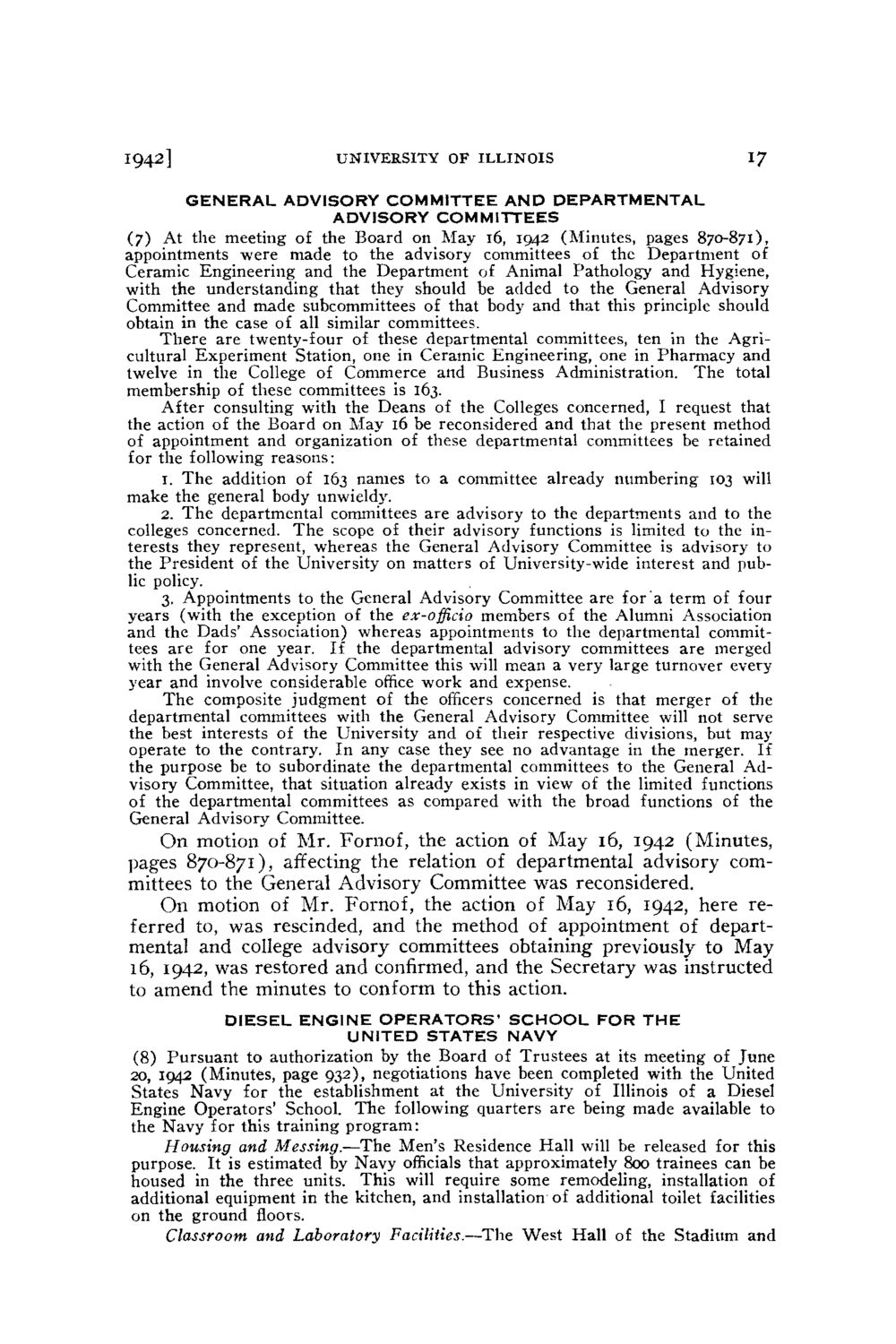| |
| |
Caption: Board of Trustees Minutes - 1944
This is a reduced-resolution page image for fast online browsing.

EXTRACTED TEXT FROM PAGE:
1942] U N I V E R S I T Y OF I L L I N O I S 17 GENERAL ADVISORY COMMITTEE AND DEPARTMENTAL ADVISORY COMMITTEES (7) At the meeting of the Board on May 16, 1942 (Minutes, pages 870-871), appointments were made to the advisory committees of the Department of Ceramic Engineering and the Department of Animal Pathology and Hygiene, with the understanding that they should be added to the General Advisory Committee and made subcommittees of that body and that this principle should obtain in the case of all similar committees. There are twenty-four of these departmental committees, ten in the Agricultural Experiment Station, one in Ceramic Engineering, one in Pharmacy and twelve in the College of Commerce and Business Administration. The total membership of these committees is 163. After consulting with the Deans of the Colleges concerned, I request that the action of the Board on May 16 be reconsidered and that the present method of appointment and organization of these departmental committees be retained for the following reasons: 1. The addition of 163 names to a committee already numbering 103 will make the general body unwieldy. 2. T h e departmental committees are advisory to the departments and to the colleges concerned. The scope of their advisory functions is limited to the interests they represent, whereas the General Advisory Committee is advisory to the President of the University on matters of University-wide interest and public policy. 3. Appointments to the General Advisory Committee are for a term of four years (with the exception of the ex-officio members of the Alumni Association and the Dads' Association) whereas appointments to the departmental committees are for one year. If the departmental advisory committees are merged with the General Advisory Committee this will mean a very large turnover every year and involve considerable office work and expense. T h e composite judgment of the officers concerned is that merger of the departmental committees with the General Advisory Committee will not serve the best interests of the University and of their respective divisions, but may operate to the contrary. In any case they see no advantage in the merger. If the purpose be to subordinate the departmental committees to the General Advisory Committee, that situation already exists in view of the limited functions of the departmental committees as compared with the broad functions of the General Advisory Committee. On motion of Mr. Fomof, the action of May 16, 1942 (Minutes, pages 870-871), affecting the relation of departmental advisory committees to the General Advisory Committee was reconsidered. On motion of Mr. Fornof, the action of May 16, 1942, here referred to, was rescinded, and the method of appointment of departmental and college advisory committees obtaining previously to May 16, 1942, was restored and confirmed, and the Secretary was instructed to amend the minutes to conform to this action. DIESEL ENGINE OPERATORS' SCHOOL FOR THE UNITED STATES NAVY (8) Pursuant to authorization by the Board of Trustees at its meeting of June 20, 1942 (Minutes, page 032), negotiations have been completed with the United States Navy for the establishment at the University of Illinois of a Diesel Engine Operators' School. The following quarters are being made available to the Navy for this training program: Housing and Messing.-—The Men's Residence Hall will be released for this purpose. It is estimated by Navy officials that approximately 800 trainees can be housed in the three units. This will require some remodeling, installation of additional equipment in the kitchen, and installation of additional toilet facilities on the ground floors. Classroom and Laboratory Facilities.—The West Hall of the Stadium and
| |